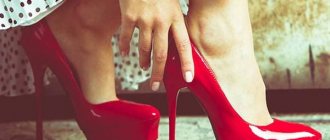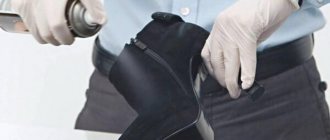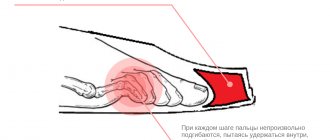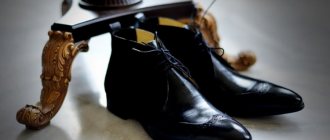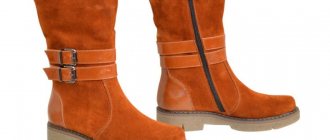When you buy a shoe, it may fit well on your foot, but after you start wearing it, it often becomes a cause of discomfort - it presses and rubs.
A similar situation is the norm for any pair - the material, due to its rigidity, needs time to take the shape of the leg. Breaking in shoes that rub the heel is possible in almost all cases, but sometimes it is necessary to take additional measures to make it easier to wear in or give up a pair when they rub too hard and calluses form.
Why do shoes rub?
New shoes rub quite often - the material of the shoe instantly adapts to the foot. The heel on the shoe will rub especially hard when the heel is very hard and does not bend under the toes when pressed - this happens in 9 out of 10 cases. But, there are other reasons that lead to pain while wearing:
- Incorrect size. A similar situation is often observed. The wrong size of sneakers or shoes leads to problems in wearing these shoes. The pair must be completely true to size - even half a size plus or minus leads to constant skin irritation and chafed feet.
- The shoe model is not suitable. The lasts used to sew shoes vary in height, fullness and other parameters. Not all models fit the same. If, when trying on in a store, the leg in the product is compressed or, conversely, the limbs are too loose, it is not advisable to buy such a pair. Shoes must fit snugly, but not put pressure on the foot.
- Swelling of the legs. An individual reason that is often ignored when buying a new pair of shoes. But, if you are prone to swelling after a long walk, you need to take models with a slightly wider last - so that the new shoes do not chafe later.
Attention! When your legs swell regularly, you should consult a doctor. Edema is one of the signs of many diseases, most often associated with disorders of the cardiovascular system.
What kind of discomfort can there be from “oaky” skin?
After purchasing shoes, you usually have to break them in before wearing them regularly. But it happens that expensive, high-quality leather shoes become stiff and begin to cause inconvenience, even though they are no longer new.
Most often this is observed in the following places:
- in the back area;
- in a sock;
- in the middle part;
- in the foot;
Discomfort is manifested by rubbing calluses and corns in the indicated places. In order to get rid of this phenomenon, you should try various methods of softening hard skin.
Correct selection
To avoid chafing on a new pair, you must approach the process of selecting and trying it on responsibly and carefully. Boots, shoes, boots, sports shoes are needed for constant wear. Convenience should be in the first position, external beauty and other parameters not directly related to wearing comfort are secondary and not so significant. Basic recommendations that will allow you to make the right choice and buy a pair that fits your foot so that it does not rub the heel area of your foot:
- When a pair that suits you in appearance seems comfortable, you still need to try it on and walk around the store for a few minutes.
- If the selected pair is larger, then you cannot buy it - the apparent convenience in the store will not protect against the fact that the backs will rub when worn.
- The block is one of the main points of choice. It must be orthopedic.
- It is preferable to purchase a pair made from natural materials.
- The time of purchase plays a role - in the evening hours the leg increases slightly in parameters, so it is during this period that you need to determine how suitable the pair is.
- Shoes with hard soles are not the best choice. A soft and flexible base is the preferred option.
It is not always possible to expect new shoes to break in after purchase. Sometimes such shoes cannot stretch - due to the characteristics of the material from which they are made, and natural circumstances - the foot can increase slightly in the evening. When buying shoes made from soft natural materials, they may expand and fit the foot, but this is only possible if the size is slightly inappropriate.
Is it possible to soften the sole?
Shoes that are too tight or cause calluses need to be treated with softening agents. Often, discomfort when walking also occurs due to hardened soles. The above describes how to return it to its previous state.
But keep in mind that these methods are not suitable for processing professional sports shoes. Careless actions can simply ruin it. Therefore, it is better to donate the product or find a buyer, and use the proceeds to purchase a new pair.
How to stretch and spread
It is pointless to hope that after purchasing you can immediately walk all day in a new pair - some inconveniences will be present in any case - until the shoes take the shape of your foot. If shoes chafe in the back or in other places, it is sometimes possible to take the pair in or stretch it. You can use specialized chemicals that are sold in shoe stores, or use mechanical stretching options.
For reference! The best option is to contact a shoemaker who specializes in fitting factory-made products to the client’s foot.
Natural material
There are several techniques to make the heel of a shoe soft and prevent further rubbing of the foot. A good way is to wrap the backdrop tightly with soft material and lightly tap it with a small hammer. During the procedure, care must be taken not to spoil the material. Mechanical options to soften shoes are not suitable for patent leather models. Pliers - a method similar to a hammer, the preparation and precautions are the same.
Table vinegar is an option to make shoes softer. Acid softens natural matter and makes it more elastic. This method involves placing a piece of cloth soaked in vinegar inside the product. Leave the acid-soaked material inside the shoes for 12 hours. In this case, you need to make sure that the fabric is not too wet - vinegar should not flow from it.
In order not to harm the material with table vinegar, which is classified as a caustic compound, it is possible to simply use a damp, hot cloth. In this option, it is necessary to additionally lubricate with glycerin those areas that fit too tightly to the leg, which leads to the formation of calluses. The product should be rubbed with glycerin only after 15 minutes have passed from the moment of laying the hot, damp cloth - it is necessary that the material of the product is sufficiently heated. Instead of glycerin, it is permissible to use castor oil. To soften it, it is also possible to rub the backdrop with the following means:
- soap;
- natural wax;
- paraffin.
You can speed up the process of shoes taking on the shape of your feet by wearing them at home. To do this, you need to moisten the sides and back of the new pair with vodka from the inside. Then you need to put on socks and walk in new shoes until they are completely dry. Subsequently, the products will fit perfectly on the leg and will not rub. But, this method helps when the purchased pair fits in size.
Attention! In a shoe store you can buy specialized aerosol products that help stretch leather shoes without damaging the material.
Artificial materials
Products made from different types of natural leather substitutes and synthetic materials require different handling. To soften shoes made from these types of materials, it is possible to use alcohol instead of vinegar. Products containing acids should not be used on artificial materials. To soften the heels, you need to make an alcohol-water solution and lightly knead the shoes with your fingers on the heel, side and in other areas where it pinches. But this method is not recommended when the product has cardboard inserts. Alcohol will cause the cardboard to lose its original shape.
Vegetable oil will help soften shoes if you rub it on the inside of the product and leave for 12 hours to absorb. After the time has expired, wipe off the remaining oil with a napkin. In addition to vegetable oil, it is possible to use glycerin. The tactics are similar, but you don’t have to wait 12 hours - when the glycerin is absorbed, you can put on the pair.
For shoes made of synthetic materials, it is possible to use several options from those used for natural products. These methods include using a damp hot cloth, a hammer and pliers. In the case of wet fabric, it is also necessary to wait until the product is completely dry, and a hammer and pliers carry similar risks.
If the back of the boot presses
Using shoe softening techniques on some boot styles is completely unacceptable. Making them softer is much more difficult. Therefore, if the heel in new boots suffers, it must be protected with the help of special means.
Pencil
This product in a stick package softens the heels of boots and at the same time protects the heel from chafing. After treatment with a pencil, the inner surface becomes sliding, which prevents rubbing of the feet. No marks remain on shoes or tights.
Band-Aid
It is glued in two layers: on the heel and on the heel. But when worn, it can all come off, form a lump and rub your feet even more.
Soft patches
A hard seam on the back can be closed by sewing or gluing a small piece of soft fabric to it. Unlike an adhesive plaster, it will not bunch up and can protect your feet from chafing. This method is not suitable for very tight shoes.
Return to store
If the shoes are rubbing and there is no way to correct the situation, there is an option to return the pair to the store. This is an ordinary procedure, the admissibility of which is supported at the legislative level - the law “On the Protection of Consumer Rights”. Based on the provisions of this law, the buyer has the right to return an unsuitable pair if the following conditions are met:
- time from the date of purchase – up to 14 days;
- the receipt has been saved and the box is in proper condition;
- The presentation of the shoes was not affected.
When a purchased pair has significant defects, the seller has the right to refuse a return. The reason for refusal is also any failure to comply with the standard conditions for return. But experts give advice - if a return is refused, the buyer has the right to write a claim addressed to the store owner, a copy of which can be sent to the manufacturer or used as a basis for going to court.
Attention! The administration is obliged to provide a complaint book upon the buyer's request. It is possible to indicate those points that caused dissatisfaction. You need to request a complaint book in case of incorrect treatment by store employees or in other circumstances that contradict the accepted standards of behavior of sellers.
When the return conditions are fully met, the buyer is given a choice - a full refund, replacement of the returned product with a new one, or selection of other shoes to taste. If another pair costs more, the buyer pays extra, and when the price difference is in his favor, the store is obliged to return the difference. Often the store also offers a discount on the product when a person comes to return purchased shoes. This action is one of the options for compensation for moral damage from the establishment.
Callus on foot
If new shoes rub and this was noticed in a timely manner, then it is not always possible to protect the foot from calluses. When the back has already rubbed, the first thing you need to do is replace the pair you are wearing with a comfortable one. But, it is not necessary to throw it away or take it to the store when the calluses first appear, and the pair fits well on the foot and does not cause any inconvenience. A sufficient measure is to wear other shoes in the following days, until the wounds heal.
Calluses can be of 2 types - dry and wet. Wet calluses are blisters containing clear or, if severely damaged, pinkish liquid. Dry ones are “corns”. Such a callus is a consequence of prolonged neglect of shoes, which presses and creates slight friction, not sufficient to form a blister. These 2 types of calluses are treated differently.
Removing blisters
Fluid-filled blisters on the feet, called dropsy, are calluses that appear due to prolonged (2 hours or more) wearing shoes that do not fit. Any touch to such calluses causes pain, so the first measure is to protect the injured area from extraneous influences using a bactericidal patch. To speed up regeneration, it is possible to make compresses from freshly cut aloe or plantain.
Attention! Doctors do not recommend piercing a water callus - this can cause infection in an open wound.
Dealing with the consequences
Dropsy simply disappears when further pressure is removed only in the first hours after formation. In the future, it is difficult to get rid of a wet callus only with the help of a band-aid and a compress. When the callus is mature, it is necessary to do something else, since when the membranes rupture, infection can occur. To avoid the negative consequences of dropsy, you must follow these instructions:
- The injured area is treated with a disinfectant - iodine, peroxide, brilliant green and the like.
- The sewing needle is disinfected in an alcohol bath for 5 minutes.
- A bubble with a large volume of liquid is punctured strictly parallel to the skin. For normal drainage of exudate, 1 puncture is not enough - 2-3 are needed from different sides.
- The walls of the bladder must remain in place - as protection for the sublayer of skin. The places where the liquid comes out are wiped with a sterile cloth and treated with hydrogen peroxide.
- A layer of antibacterial ointment is applied to the wound under a bactericidal patch or bandage.
If you follow the puncture technique and maintain sufficient sterility during the process, the likelihood of infection entering the wound surface is minimal. After the procedure, you need to regularly replace the bandage - every 6 hours until complete healing. Watery calluses, especially after a puncture, heal easily, fairly quickly and rarely become a serious problem.
Removing dry calluses
Dry calluses are hardened areas of the skin that occur due to constant pressure. They are treated with baths and compresses. They recommend a folk method - put potato juice in the form of a compress overnight. It will soften rough skin. It is recommended to use baths of a pale pink solution of potassium permanganate or with chamomile infusion. The liquid in the bath should have a temperature of up to – 39 °C.
Useful tips
In conclusion, some more useful tips:
- buy shoes in the afternoon, when your feet are slightly swollen, to avoid problems with the size later;
- do not put on new shoes for the whole day at once, break them in gradually;
- Cover frequently rubbed areas with adhesive tape in advance. This will avoid the appearance of calluses;
- if the back of the shoes rubs, lubricate it with paraffin or soap;
- Buy shoes for important events in advance, keep in mind that you will need time to stretch. Read about how to quickly break in new shoes in our other article.
If you have already tried the methods listed above or have your own method of stretching shoes, share your experience and tips with us in the comments.
Preventing calluses
A correctly selected pair of shoes does not guarantee the absence of discomfort and calluses. It is necessary to wear the pair correctly so that it fits the foot. However, there are some preventative measures that can prevent the formation of calluses. To avoid chafing on products of the appropriate size and with a comfortable fit, it is recommended to apply a bactericidal patch to the leg in high-risk areas.
For reference! There are specialized linings (heel pads) that are placed in shoes. They are soft and therefore stop strong friction.
Moisturizing cream
Applying moisturizer to your heels and inner heels can reduce the likelihood of foot chafing. The skin remains moisturized and soft thanks to the cream - it is protected from the aggressive influence of hard materials. The cream must be applied before putting on shoes; only the skin in contact with the hard parts of the product should be treated with the product.
Aloe vera
Products with aloe vera extract, due to their moisturizing effect, can prevent the formation of calluses that occur due to friction and wearing certain types of shoes. These products also have some antimicrobial properties that reduce the likelihood of developing infections. After applying the greasy layer of the product, you need to wait for absorption. You need to use preparations with aloe 2 times a day.
Talc
Talc is used to eliminate unpleasant foot odors. But, it can also prevent the occurrence of calluses. Talc absorbs moisture formed due to sweat. Apply the product to the inner surface of the products and the skin of the feet, in places where it comes into contact with shoes. Talc will also eliminate unpleasant odor from shoes if it has already appeared.
What to apply after the cream
Any shoes, even if they are intended to be worn in conditions of high humidity (winter or autumn), need protection from moisture and dirt.
Therefore, in addition to daily cleaning, it is necessary to additionally treat it with special products.
In modern shoe stores you can find shoe grease that does an excellent job of this task.
It can be of either natural or artificial origin, but in any case it will help extend the life of the product. The product is applied to the surface of the material and left overnight, during which time it soaks it well. Before covering the entire product with fat, test it on an inconspicuous area.
Information. Sometimes after using such products, shoes become an order of magnitude darker. It is better to check this in advance to avoid unpleasant consequences.
There is no need to use such impregnations daily. It is enough to treat the product once a week so that it does not suffer from moisture. The product can be applied over colored cream to form a protective film.
Particular care should be taken to lubricate the places where the body elements meet. A well-impregnated seam is guaranteed not to let water through and will become more durable.
Even patent leather shoes need such treatment. To care for such products, it is recommended to purchase a special balm or oil. They will not only help protect the material, but also prevent it from tarnishing.



